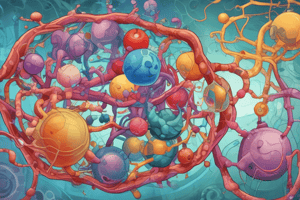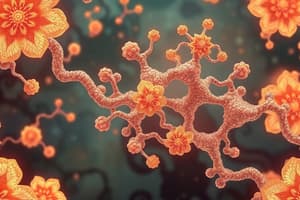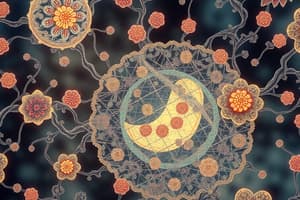Podcast
Questions and Answers
Are enzyme-catalyzed reactions always decompositions?
Are enzyme-catalyzed reactions always decompositions?
- No, they only work under acidic conditions.
- Yes, all enzymes function only in decomposition.
- No, they can also synthesize larger molecules. (correct)
- Yes, they only break down molecules.
What effect does cold temperature have on enzyme activity?
What effect does cold temperature have on enzyme activity?
- It slows down the reaction rate. (correct)
- It speeds up the reaction rate.
- It denatures the enzymes.
- It has no effect; enzymes are unaffected by temperature changes.
How does heat affect enzyme activity?
How does heat affect enzyme activity?
- It slows down enzyme reactions significantly.
- It maintains the same reaction rate as at lower temperatures.
- It denatures the enzymes and can increase the reaction rate. (correct)
- It has no noticeable impact on the enzymes.
What impact does a change in pH have on enzyme activity?
What impact does a change in pH have on enzyme activity?
What kind of biomolecule are enzymes categorized as?
What kind of biomolecule are enzymes categorized as?
What does it mean for enzymes to be specific?
What does it mean for enzymes to be specific?
What is the monomer of an enzyme?
What is the monomer of an enzyme?
Which statement about the lab enzyme used is correct?
Which statement about the lab enzyme used is correct?
What is the primary role of a biological buffering system when the pH of an environment becomes too acidic?
What is the primary role of a biological buffering system when the pH of an environment becomes too acidic?
Which of the following best describes how carbon's bonding capability relates to its valence electrons?
Which of the following best describes how carbon's bonding capability relates to its valence electrons?
Which characteristic defines a polar molecule?
Which characteristic defines a polar molecule?
What defines a nonpolar molecule?
What defines a nonpolar molecule?
Which of the following types of molecules would be classified as hydrophilic?
Which of the following types of molecules would be classified as hydrophilic?
Which type of molecules is typically hydrophobic?
Which type of molecules is typically hydrophobic?
What is the primary function of nucleic acids in biological systems?
What is the primary function of nucleic acids in biological systems?
Which type of reaction involves the breaking down of molecules using water?
Which type of reaction involves the breaking down of molecules using water?
What role do lipids primarily serve in organisms?
What role do lipids primarily serve in organisms?
How do unsaturated fats differ from saturated fats?
How do unsaturated fats differ from saturated fats?
What constitutes the R-group of an amino acid?
What constitutes the R-group of an amino acid?
What describes the secondary structure of proteins?
What describes the secondary structure of proteins?
What is the primary function of enzymes in biochemical reactions?
What is the primary function of enzymes in biochemical reactions?
What distinguishes competitive inhibitors from noncompetitive inhibitors?
What distinguishes competitive inhibitors from noncompetitive inhibitors?
How does the lock-and-key mechanism differ from the induced-fit mechanism of enzyme action?
How does the lock-and-key mechanism differ from the induced-fit mechanism of enzyme action?
What best explains the reusability of enzymes?
What best explains the reusability of enzymes?
How many molecules are represented in the molecular formula $2C_2H_4O_2$?
How many molecules are represented in the molecular formula $2C_2H_4O_2$?
How many atoms of hydrogen are represented in the molecular formula $2C_2H_4O_2$?
How many atoms of hydrogen are represented in the molecular formula $2C_2H_4O_2$?
What is the primary characteristic of an ionic compound?
What is the primary characteristic of an ionic compound?
What is the definition of a covalent compound?
What is the definition of a covalent compound?
How many valence electrons does nitrogen (N) have?
How many valence electrons does nitrogen (N) have?
What type of bond is formed when sodium (Na) and fluorine (F) combine?
What type of bond is formed when sodium (Na) and fluorine (F) combine?
What does it mean for a compound to be polar covalently bonded?
What does it mean for a compound to be polar covalently bonded?
What is the relationship between the number of bonds nitrogen can make and its valence electrons?
What is the relationship between the number of bonds nitrogen can make and its valence electrons?
Why can water dissolve polar or ionic compounds, but not nonpolar compounds like fat?
Why can water dissolve polar or ionic compounds, but not nonpolar compounds like fat?
What are the products of water ionization?
What are the products of water ionization?
What does it indicate when a solution is described as acidic?
What does it indicate when a solution is described as acidic?
What characterizes a basic solution?
What characterizes a basic solution?
What does a neutral solution signify in terms of ion concentration?
What does a neutral solution signify in terms of ion concentration?
What does the pH scale measure?
What does the pH scale measure?
Which assertion about hydrogen bonding and water is true?
Which assertion about hydrogen bonding and water is true?
Which acid was commonly used in pH lab experiments to change the pH of materials?
Which acid was commonly used in pH lab experiments to change the pH of materials?
Flashcards
Molecular Formula
Molecular Formula
The number of atoms of each element in a molecule. It represents the relative proportions of each element.
Covalent Bonds
Covalent Bonds
Bonds formed when atoms share electrons to achieve a stable electron configuration.
Ionic Bonds
Ionic Bonds
Bonds formed when atoms transfer electrons to achieve a stable electron configuration. The transfer results in oppositely charged ions that attract each other.
Valence Shell
Valence Shell
Signup and view all the flashcards
Valence Electrons
Valence Electrons
Signup and view all the flashcards
Covalent Compound
Covalent Compound
Signup and view all the flashcards
Ionic Compound
Ionic Compound
Signup and view all the flashcards
Polar Covalent Bond
Polar Covalent Bond
Signup and view all the flashcards
Why can water dissolve polar or ionic compounds?
Why can water dissolve polar or ionic compounds?
Signup and view all the flashcards
What is hydrogen bonding?
What is hydrogen bonding?
Signup and view all the flashcards
What are the products of water ionization?
What are the products of water ionization?
Signup and view all the flashcards
What makes a solution acidic?
What makes a solution acidic?
Signup and view all the flashcards
What makes a solution basic?
What makes a solution basic?
Signup and view all the flashcards
What makes a solution neutral?
What makes a solution neutral?
Signup and view all the flashcards
What is the pH scale?
What is the pH scale?
Signup and view all the flashcards
How do organisms regulate their pH?
How do organisms regulate their pH?
Signup and view all the flashcards
Biological Buffer
Biological Buffer
Signup and view all the flashcards
Buffer's Response to Basic pH
Buffer's Response to Basic pH
Signup and view all the flashcards
Buffer's Response to Acidic pH
Buffer's Response to Acidic pH
Signup and view all the flashcards
Valence Electrons and Bonding
Valence Electrons and Bonding
Signup and view all the flashcards
Organic Molecule Definition
Organic Molecule Definition
Signup and view all the flashcards
Polar Molecule
Polar Molecule
Signup and view all the flashcards
Nonpolar Molecule
Nonpolar Molecule
Signup and view all the flashcards
Hydrophilic Molecules
Hydrophilic Molecules
Signup and view all the flashcards
What are enzymes?
What are enzymes?
Signup and view all the flashcards
Why are enzymes specific?
Why are enzymes specific?
Signup and view all the flashcards
How does cold affect enzyme activity?
How does cold affect enzyme activity?
Signup and view all the flashcards
How does heat affect enzyme activity?
How does heat affect enzyme activity?
Signup and view all the flashcards
How does pH affect enzyme activity?
How does pH affect enzyme activity?
Signup and view all the flashcards
What kind of molecule is an enzyme?
What kind of molecule is an enzyme?
Signup and view all the flashcards
Are enzyme-catalyzed reactions always decompositions?
Are enzyme-catalyzed reactions always decompositions?
Signup and view all the flashcards
What enzyme was used in the lab? What was the substrate?
What enzyme was used in the lab? What was the substrate?
Signup and view all the flashcards
What are lipids?
What are lipids?
Signup and view all the flashcards
What's the difference between saturated and unsaturated fats?
What's the difference between saturated and unsaturated fats?
Signup and view all the flashcards
What is the R-group of an amino acid, and how do amino acids differ?
What is the R-group of an amino acid, and how do amino acids differ?
Signup and view all the flashcards
Describe/draw the four levels of organization of protein molecules.
Describe/draw the four levels of organization of protein molecules.
Signup and view all the flashcards
How do enzymes affect the progress of a reaction?
How do enzymes affect the progress of a reaction?
Signup and view all the flashcards
What's the difference between competitive and noncompetitive inhibitors?
What's the difference between competitive and noncompetitive inhibitors?
Signup and view all the flashcards
Compare and contrast the lock-and-key and induced-fit mechanisms for enzyme action.
Compare and contrast the lock-and-key and induced-fit mechanisms for enzyme action.
Signup and view all the flashcards
Explain the reusability of enzymes and substrates.
Explain the reusability of enzymes and substrates.
Signup and view all the flashcards
Study Notes
Molecular Structures
- Atomic Structure: Atoms consist of protons, neutrons, and electrons.
- Valence Electrons: Outermost electrons that determine bonding capacity.
- Ionic Compounds: Formed when atoms gain or lose electrons to become stable ions.
- Covalent Compounds: Formed when atoms share electrons to become stable.
- Polar Covalent Bonds: Unequal sharing of electrons creates a partial positive and negative charge.
- Water's Properties: Water's polarity allows it to dissolve many polar and ionic substances. Hydrogen bonding creates unique properties.
- pH Scale: Measures acidity and basicity of a solution.
- Acids: Have a higher concentration of H+ ions.
- Bases: Have a higher concentration of OH- ions.
- Neutral: Equal concentration of H+ and OH- ions.
- pH Regulation: Organisms maintain a relatively stable pH through buffers.
Biomolecules
- Organic Molecules: Contain carbon and hydrogen.
- Polar Molecules: Unequal sharing of electrons creates a partial positive and negative charge.
- Nonpolar Molecules: Equal sharing of electrons creates no charge.
- Hydrophilic: Water-loving molecules, polar molecules.
- Hydrophobic: Water-repelling molecules, nonpolar molecules.
- Carbohydrates: Monosaccharides, used as energy source.
- Lipids: Fatty acids, energy storage, insulation.
- Proteins: Amino acids, enzymes, structural roles.
- Nucleic Acids: Nucleotides, carry genetic information.
Synthesis and Breakdown of Biomolecules
- Condensation Reaction: Water is removed to bond molecules together.
- Hydrolysis Reaction: Water is added to break down molecules.
Enzymes
- Enzyme Function: Biological catalysts that speed up chemical reactions.
- Enzyme Structure: Proteins with specific 3D shapes that provide an active site.
- Substrate Specificity: Enzymes bind to specific substrates.
- Enzyme Inhibitors: Competitive inhibitors block the active site; non-competitive inhibitors change the enzyme's shape.
- Temperature and pH: Affect enzyme activity; extreme conditions denature enzymes.
Studying That Suits You
Use AI to generate personalized quizzes and flashcards to suit your learning preferences.
Related Documents
Description
Test your understanding of molecular structures and biomolecules in this quiz. Explore concepts such as atomic structure, ionic and covalent compounds, and the properties of water. Additionally, delve into the role of acids, bases, and pH in biological systems.




